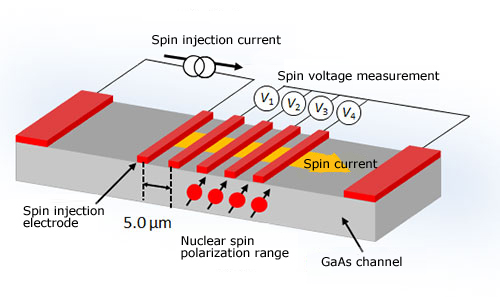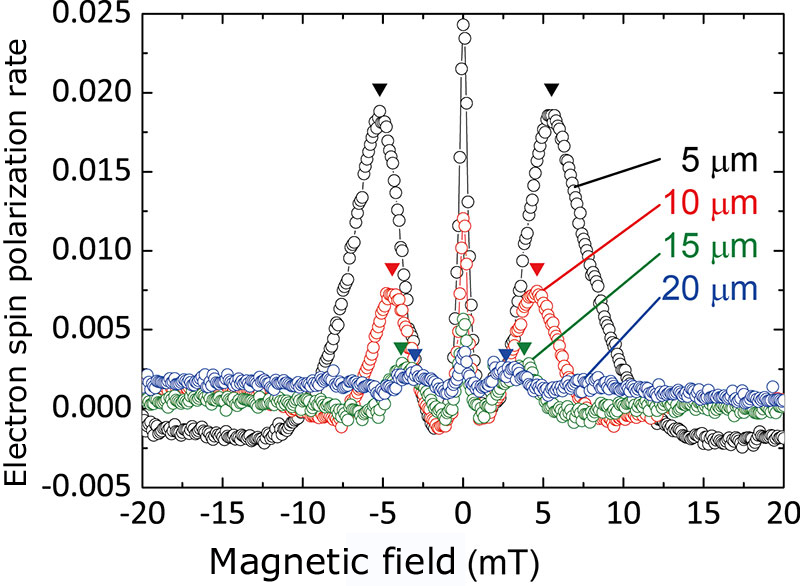News
Research Results
Long-lived nuclear spin polarization observed: taking a big step towards the development of spin current devices with semiconductor channels
[Highlights]
- Researchers have observed long-lived nuclear spin polarization in a spin injection device.
- Researchers have also detected the spatial distribution of nuclear spins by using a multi-electrode spin detection device.
- This study contributes significantly to the development of spin current devices using a semiconductor as a channel.
[Overview]
A research group consisting of Junichi Shiogai (Assistant Professor, Institute for Materials Research, Tohoku University), Makoto Kohda (Associate Professor, Graduate School of Engineering, Tohoku University), and Junsaku Nitta (Professor at the same institution) has conducted collaborative research with a research group consisting of Tsutomu Nojima (Associate Professor, Institute for Materials Research, Tohoku University) and Dieter Weiss (Professor, University of Regensburg, Germany). Using a lateral spin injection device with a ferromagnetic semiconductor, (Ga,Mn)As, they have detected nuclear spin polarization in a semiconductor GaAs channel in a weak magnetic field and demonstrated that the nuclear spin polarization is maintained for as far as 20 μm. Since nuclear spins have a longer coherence time than electron spins, the results of this study are expected to contribute significantly to the research and development of spin devices with semiconductors.
This study was published online in the American journal “Applied Physics Letters” on March 27, 2018, and selected as Editor’s Pick (featured by the editorial team). This study was supported by the Japan Society for the Promotion of Science through Grants-in-Aid for Scientific Research.
[Research Background]
Recently, vigorous efforts have been made to develop spintronics devices with new functions by electrically controlling two degrees of freedom of electrons: charge and spin. In particular, Group III-V semiconductors, such as GaAs, which have direct energy-band gaps and allow the gate control of electron spins, have been drawing attention as channel materials of spin transistors and potential materials to produce spin LEDs. Because Ga and As atoms in these semiconductors have finite nuclear spins, nuclear spin polarization due to electron spin flip-flops can produce a nuclear magnetic field with a magnitude of at most a few Tesla. This can significantly change the coherence time of electron spins. Therefore, directly observing interactions between nuclear magnetic fields and spin currents and understanding their mechanisms have become the key to the research and development of spin current devices with semiconductor channels.
Previous studies on nuclear spin polarization in GaAs-based thin film devices focused on quantum Hall states in strong magnetic fields and circular polarization spin LED devices; however, no studies have examined the spatial distribution of nuclear spin polarization or effects on spin currents in the micro channels of the lateral spin injection devices, which serve as an essential component of the spin transistors.
[Achievements]
Figure 1 shows the lateral spin injection device prepared in this study. Equipped with multiple spin detection electrodes, this device can be used to measure the distance dependence of the electron spin polarization rate based on magnetic resistance as well as measure the nuclear spin polarization rate and its spatial distribution as spin voltage.

Figure 1. Spin injection electrodes used in this study
Figure 2 shows the magnetic resistance measurements. In addition to the peak resistance around the zero magnetic field, which indicates the accumulation of electron spins, satellite peaks (inverted triangles) are observed, which indicates the polarization of nuclear spins. The magnetic field parameters around these satellite peaks are corresponding to the nuclear magnetic field parameters which induce the spin currents. Since the satellite peaks are observed at 20 μm from the spin injection electrode, it is assumed that the nuclear spin polarization is maintained for as far as 20 μm from the spin injection source. Moreover, these measurement results show that the satellite peaks are shifted towards the weak magnetic field as they are moving away from the spin injection electrode, and the nuclear spin polarization rate (the nuclear magnetic field that induces the spin current) is declining as the spin currents are transmitting.

Figure 2. Spin voltage measurements at different spin detection electrodes
This is the first study that elucidated relations between spin currents and nuclear spins in a lateral semiconductor channel. Since nuclear spins have a longer spin coherence time than electron spins, they are expected to serve as quantum memories. By using a micro spin injection device, this study has electrically generated and detected nuclear spin polarization in a weaker magnetic field than when using conventional quantum Hall and spin optical devices. Thus, this study has established the basic technology to use spin currents for writing and reading spin information.
The findings of this study on interactions between spin currents and nuclear spins are expected to contribute to the future development of semiconductor spintronics devices
[Publication Information]
Journal: Applied Physics Letters 112, 132403 (2018)
Title: Spatial variation of dynamic nuclear spin polarization probed by the non-local Hanle effect
Authors: J. Shiogai, M. Ciorga, M. Utz, D. Schuh, M. Kohda, D. Bougeard, T. Nojima, D. Weiss, and J. Nitta
URL: https://aip.scitation.org/doi/10.1063/1.5020314
DOI: 10.1063/1.5020314
Links:
Tohoku University (Japanese)
Graduate School of Engineering, Tohoku University (Japanese)

